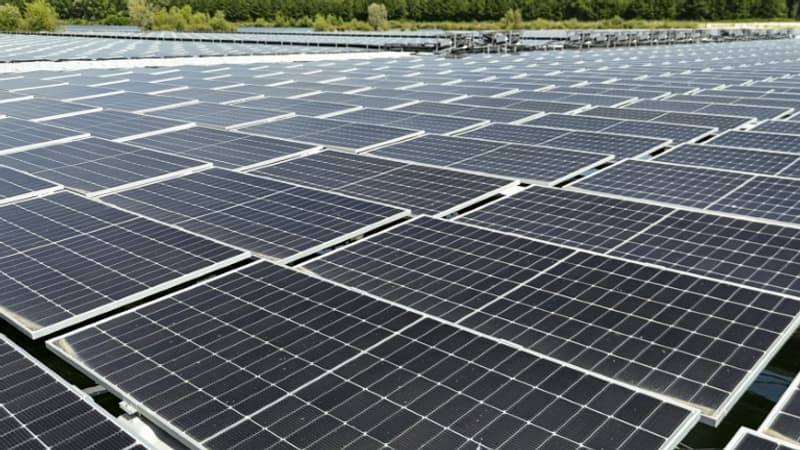The figure multiplied by two in one year: according to the report of the RTE electricity network, France died 2 TWH (Terawattheurs) of renewable electricity in the first half of 2025, against 1.1 TWh in 2024. Behind this barbarian term, an increasingly restrictive reality for actors in renewable energy in terms of consumers: France is due to overproductions.
In detail, France has launched almost 0.8 wind production TWH (it was 0.7 TWh in 2024) and 1.2 TWH of solar energy, an amount multiplied by three compared to the first six months of 2024. In total, France produced 273.4 TWH of electricity (all combined energy sources), this waste represents 0.7% of the losses.
The main mechanism is quite simple: renewable energies have intermittent productions: the same stable amount of energy does not stable. During favorable climatic events (no more wind, more sun), they can provide too much energy and a surplus appears that we decide to lose, it is “clear”.
This, for several reasons: non -retainable or partial attachment to the network of production facilities, or cables and links already saturated; Or even the production of such an amount of energy that it is impossible to compensate, storing electricity or especially reducing the production of qualified pilot energies (of which production can be adjusted) such as hydroelectricity and nuclear.
Growth crisis
Renewable energies are also victims of a growth crisis: 2.1 GW (Gigawatts) of solar capacity and 0.2 GW of wind capacity (terrestrial and sea) installed between January and May, which carries the capacity at the end of May from 2025 to 26.4 GW for solar, and 24.6 for wind turbines. Solar energy production increased 3.5 TWH compared to last year; In June, solar energy even exceeded nuclear in France. This mechanically increases the risks of surplus and, therefore, the registered losses. RTE emphasizes that the figures explode for solar energy.
Despite exports to foreign countries that increase (France exported 37.6 TWH during the first 6 months, or around 13%), the phenomenon should not weaken. Jean-Paul Harreman, director of the Montel Analytics cabinet, explains that the worst is this summer.
This increase should also continue due to the difficulties experienced by the nuclear sectors, pending new generation reactors, EDF has faced corrosion and hydroelectric problems, with recurring droughts.
Negative and demand prices
The main consequence of this increase in the renewable energy rate is the variation in prices: during production peaks, prices can be negative, industrialists who prefer to sell in a loss instead of extinguishing their production sites, long to restart. This was the case for 363 hours in France, a record again, even if it is less than in Spain (459 hours) or in Sweden (506 hours), two countries with ambitious renewable strategies. On the contrary, at night, prices shoot, because renewable production leaves room for fossil plants.
Paradox elevated by RTE: Despite the increase in waste and increased negative prices, the average electricity price does not fall. It even increases, to € 67/MWh on average in the first six months of 2025. The sign of a divergence of deep profitability between different energy sources: renewable energies become, with much, the source of less expensive electricity production. This overlaps the figures of Irena, the International Renewable Agency: 91% of the new renewable capacities installed in 2024 delivered electricity cheaper than its fossil counterparts.
For consumer energy manufacturers, variations can be complicated to handle. The consequences on the network, regularly in tension, are also important. In terms of consumers, the main consequence can be to reduce the purchase price, for houses that produce their electrons: it is more consistent for self -esteem. In terms of invoices, there is no immediate impact: this energy on negative lands is consumed by companies. And penalized electricity producers are compensated by the State, which can cost public finances and have a negative effect on invoices in the end (On the contrary, contracts establish that producers are part of their profits when prices are very high).
GUARDY INVEST THE BETTER CONTROL PICOS
For electricity producers, negative prices are problematic, because they limit profits and, above all, endanger the facilities. In the case of a negative price, they often prefer to sell but can stop production; An option explored by the Spanish Iberdrola, for example, in its fleet of wind turbines against Saint-Brieuc (Côtes d’Amor). The turbines stop momentarily, but this Stop and go would damage them in the long term.
On the EDF side, another problem appears: when renewable peaks are produced, nuclear power plants must be placed in rest in rest and not produce. But these electric plants can obviously be stopped, even less for a few hours every day; Therefore, EDF has costs that remain the same, without the production that accompanies it.
The solutions to compensate for these peaks, which, therefore, unbalance the network and its actors, are multiple. Promote, first, the consumption of electricity over time, especially in the afternoon during the summer, in the middle of a solar peak. This implies a review of the prices offered to consumers by EDF. The installation of cargo stations for electric vehicles, widespread in the United States or Germany, could encourage recharges during extraction hours and provide support to the network.
Above all, RTE plans an investment of 100 billion euros to adapt the infrastructure to the solar hatch. This plan aims to strengthen interconnections, develop storage and modernize the network to allow you to better support variations. Enedis must administer a million production points, to be connected.
Without these accessories, it remains to tolerate the losses generated by the peaks: “It can make your network absorb every hour of kilovas produced. Or, because the wind or the sun does not generate any marginal cost, tolerate to lose a little, provided that it would finally produce it enough,” explains, for example, specialist Mark Hedin, Aurora Energy Research.
Source: BFM TV


